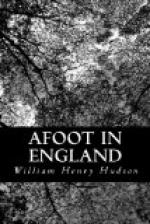Chapter Twenty-One: Stonehenge
That American from Indiana! As it was market day at Salisbury I asked him before we parted if he had seen the market, also if they had market days in the country towns in his State? He said he had looked in at the market on his way back from the cathedral. No, they had nothing of the kind in his State. Indiana was covered with a network of railroads and electric tram lines, and all country produce, down to the last new-laid egg, was collected and sent off and conveyed each morning to the towns, where it was always market day.
How sad! thought I. Poor Indiana, that once had wildness and romance and memories of a vanished race, and has now only its pretty meaningless name!
“I suppose,” he said, before getting on his bicycle, “there’s nothing beside the cathedral and Stonehenge to see in Wiltshire?”
“No, nothing,” I returned, “and you’ll think the time wasted in seeing Stonehenge.”
“Why?”
“Only a few old stones to see.”
But he went, and I have no doubt did think the time wasted, but it would be some consolation to him, on the other side, to be able to say that he had seen it with his own eyes.
How did these same “few old stones” strike me on a first visit? It was one of the greatest disillusionments I ever experienced. Stonehenge looked small—pitiably small! For it is a fact that mere size is very much to us, in spite of all the teachings of science. We have heard of Stonehenge in our childhood or boyhood—that great building of unknown origin and antiquity, its circles of stones, some still standing, others lying prostrate, like the stupendous half-shattered skeleton of a giant or monster whose stature reached to the clouds. It stands, we read or were told, on Salisbury Plain. To my uninformed, childish mind a plain anywhere was like the plain on which I was born—an absolutely level area stretching away on all sides into infinitude; and although the effect is of a great extent of earth, we know that we actually see very little of it, that standing on a level plain we have a very near horizon. On this account any large object appearing on it, such as a horse or tree or a big animal, looks very much bigger than it would on land with a broken surface.
Oddly enough, my impossible Stonehenge was derived from a sober description and an accompanying plate in a sober work —a gigantic folio in two volumes entitled “A New System of Geography”, dated some time in the eighteenth century. How this ponderous work ever came to be out on the pampas, over six thousand miles from the land of its origin, is a thing to wonder at. I remember that the Stonehenge plate greatly impressed me and that I sacrilegiously cut it out of the book so as to have it!




